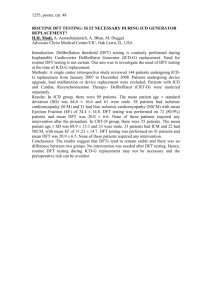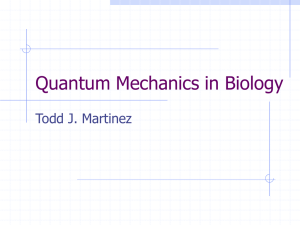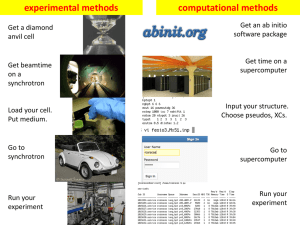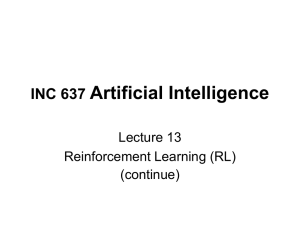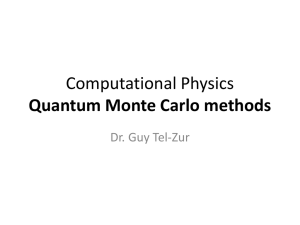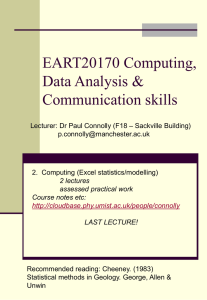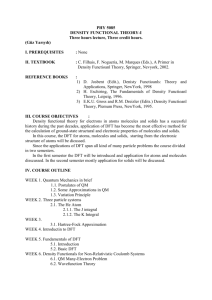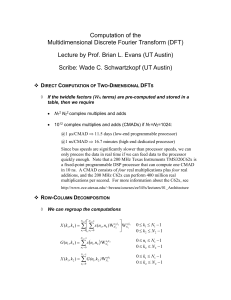qwalk_intro
advertisement
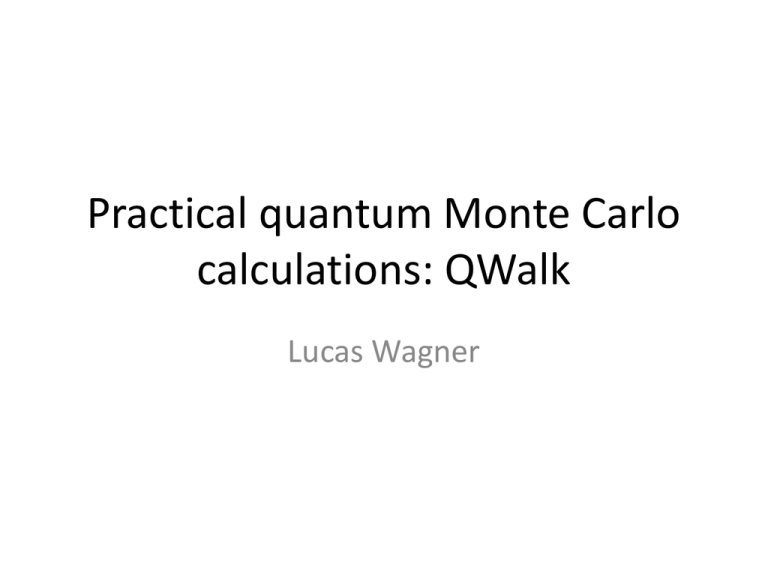
Practical quantum Monte Carlo calculations: QWalk Lucas Wagner • Used by >100 people • Open source: http://www.qwalk.org • Solids, liquid, gas phase • Scales to >20,000 processor cores Simple separable architecture Distributed development Lattice constant Experiment (eV) Experiment (Angstroms) Cohesive energy FN-DMC (eV) FN-DMC (Angstroms) Kolorenc and Mitas Rep. Prog. Phys. 74 (2011) 026502 Petruzielo, Toulouse, and Umrigar J. Chem. Phys. 136, 124116 (2012) Information passed from DFT/Hartree-Fock program to QMC code: • Positions of atoms • Pseudopotentials • The one-particle orbitals and their occupations QWalk supports reading this information from several DFT/quantum chemistry codes: • GAMESS • Gaussian • NWChem • SIESTA • ABINIT • CRYSTAL The GAMESS-QWalk pipeline Most developed interface for molecules. 5 steps to accurate calculations 1. Choose pseudopotentials and basis sets 2. Run GAMESS 3. Run gamess2qmc 4. Add a Jastrow factor and optimize 5. Run diffusion Monte Carlo Step 4a: Jastrow factor • General form of wave function YT (R) = Det[j i (rj )]exp(U) – Slater determinant (Hartree-Fock) – Two-body Jastrow U =0 U = å åc kei ak (riI ) +å åc kee bk (rij ) iI k ij k – Three-body Jastrow eei U = two - body +ååc klm [ak (riI )al (rjI ) + ak (rjI )al (riI )]bk (rij ) ijI klm • We optimize only the c coefficients 2-body or 3-body? 2-body: • Homogeneous systems (silicon, hydrogen, etc) • Very cheap 3-body: • Strongly inhomogeneous systems • More expensive Can always check how much it improves the wave function How to know if if a wave function is good Properties of an exact ground state wave function: • Energy is minimized • Variance of the local energy is zero Usually the variance decreases by a factor of ~2 between the Slater determinant and the SlaterJastrow wave function. Step 5: Diffusion Monte Carlo Timestep: you must extrapolate this to zero The ultimate accuracy of DMC calculations is determined by the nodes, the zeros of your trial wave function. How to immediately recognize that your run is messed up: The variance (sigma in QWalk) is high(>10). Causes: • Poor basis • Unconverged DFT/HF run • Bad geometry The kinetic energy should match the DFT/HF kinetic energy. Conceptual questions: How does the total energy of QMC relate to: • DFT? • Hartree-Fock? • Coupled-cluster? A discussion on error bars All numbers in QWalk are reported with one-sigma stochastic errors. There is a 33% chance that the true average is outside this range. Errors are reduced as 1/sqrt(T), where T is the computer time. Using QWalk Evaluate Slater determinant properties Optimize a Jastrow factor ->filename.wfout Run diffusion Monte Carlo with optimized SlaterJastrow trial function Dealing with stochastic simulation (VMC/DMC) • Calculation is divided into blocks of moves • Averaged information for each block is appended to filename.log • Checkpoint is written every block to filename.config To decrease error bars, just rerun the input file, the calculation will continue where it left off. Units • Energy: 1 Hartree=27.216 eV • Distance: 1 Bohr=0.529177 Angstrom Discussion points • • • • When might one want to use QMC? What questions can it answer? When is it easy? When is it hard? • When might fixed node error be large? Much of the challenge in QMC calculations is setting up the pseudopotentials, getting DFT converged, etc. Not so much the actual run. Where does the fixed-node approximation fail? Most of the time, the approximation is good. Let’s look at a classic case where it fails: Be atom. 2s 1s Hartree-Fock ground state 2p Almost the same energy HF trial nodes: ~85% of the correlation energy Including the 2p orbitals: ~99% -- almost exact! Lucas K. Wagner, NSE C242 & Phys C203, Spring 2009, U.C. Berkeley

